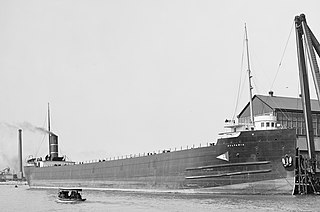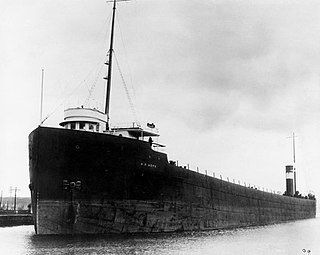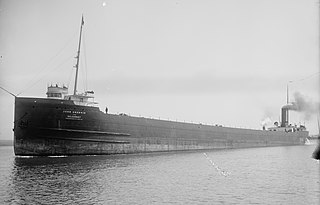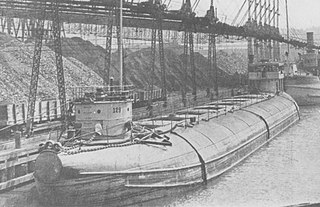
The SS William G. Mather is a retired Great Lakes bulk freighter now restored as a museum ship in Cleveland, Ohio, one of five in the Great Lakes region. She transported cargo such as ore, coal, stone, and grain to ports throughout the Great Lakes, and was nicknamed "The Ship That Built Cleveland" because Cleveland's steel mills were a frequent destination.
The American Ship Building Company was the dominant shipbuilder on the Great Lakes before the Second World War. It started as Cleveland Shipbuilding in Cleveland, Ohio in 1888 and opened the yard in Lorain, Ohio in 1898. It changed its name to the American Ship Building Company in 1900, when it acquired Superior Shipbuilding, in Superior, Wisconsin; Toledo Shipbuilding, in Toledo, Ohio; and West Bay Shipbuilding, in West Bay City, Michigan. With the coming of World War I, the company also acquired Buffalo Dry Dock, in Buffalo, New York; Chicago Shipbuilding, in Chicago, Illinois; and Detroit Shipbuilding, in Wyandotte, Michigan. American Shipbuilding ranked 81st among United States corporations in the value of World War II military production contracts.

The J. B. Ford was a steamship bulk freighter that saw service for 112 years on the Great Lakes of the United States and Canada.

Howard M. Hanna Jr. was a 500 ft (150 m) Great Lakes freighter that had a lengthy, 75-year career on the Great Lakes of Canada and America. Hanna was a product of the Cleveland Shipbuilding Company of Cleveland, Ohio. The ship was commissioned by the Richardson Transportation Company to haul iron ore, coal and grain. She had a cargo capacity of 9,200 tons of bulk cargo, or 323,000 bushels of grain.

The SS Sylvania was a 572-foot (174 m) Great Lakes freighter that had a long 79-year career on the Great Lakes. Sylvania was built by the West Bay City Shipbuilding Company of West Bay City, Michigan as hull #613. She was built for the Duluth Steamship Company of Duluth, Minnesota.

Augustus B. Wolvin was a 560 ft (170 m) long Great Lakes freighter that had a 63-year career on the Great Lakes. Augustus B. Wolvin was a product of the American Shipbuilding Company of Cleveland, Ohio. She was built for the Acme Steamship Company of Duluth, Minnesota.

The SS William G. Mather was a 533-foot (162 m) long Great Lakes freighter that was built in 1905, by the Great Lakes Engineering Works (GLEW) of Ecorse, Michigan, for the Grand Island Steamship Company. Her keel was laid on May 18, 1905. She was launched on September 23, 1905, as hull #9. The ship was named after William G. Mather, the Cleveland-Cliffs executive. She was powered by a 2,000-horsepower (1,500 kW) triple expansion steam engine which was attached to a single fixed-pitch propeller. She was fueled by two coal-fired Scotch marine boilers.

The Frank C. Ball was an American Bulk carrier that was built by the Great Lakes Engineering Works of Ecorse, Michigan, for the Globe Steamship Company of Duluth, Minnesota. She was launched on December 9, 1905, as hull #14. She was powered by a 1,700 horsepower triple expansion steam engine and fueled by two coal-fired Scotch marine boilers. Even though Ball was built in 1905, she only entered service in 1906.

The H.P. Bope was an American steel-hulled, propeller-driven Great Lakes freighter built in 1907 by the Superior Shipbuilding Company of Superior, Wisconsin for service on the Great Lakes of North America. She was used to transport bulk cargoes such as coal, iron ore and grain.

SS B.F. Jones was a steel-hulled Great Lakes freighter that was named after one of the founders of the Jones and Laughlin Steel Company. She was launched on December 30, 1905 as hull #15. She operated from April 1906 to August 21, 1955 she collided with the steamer Cason J. Callaway. After inspection she was declared a constructive total loss, and scrapped in Duluth, Minnesota.

The John Sherwin was an American steel-hulled, propeller-driven Great Lakes freighter built in 1906 by the West Bay City Shipbuilding Company of Bay City, Michigan for service on the Great Lakes of North America. She was used to transport bulk cargoes such as coal, iron ore and grain. She served from her launching in 1906 to her scrapping in 1974, in Germany.

SS Onoko was an iron hulled Great Lakes freighter. She was launched in 1882 in Cleveland, Ohio as hull number #4, and sank on September 14, 1915 in Lake Superior near Knife River, Minnesota. Onoko is thought to be the prototype for every single steel hulled Great Lakes Bulk carrier that ever sailed. These vessels made possible the cheap transport of bulk cargoes such as iron ore, coal and limestone. Her wreckage still remains on the bottom of Lake Superior and was listed on the National Register of Historic Places in 1992.













